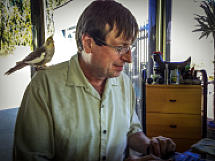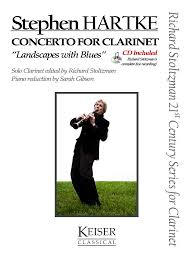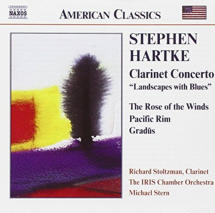
Stephen Hartke
CONCERTO FOR CLARINET AND ORCHESTRA
"Landscapes with Blues" (2001)
Commissioned for Richard Stoltzman and the IRIS Chamber Orchestra, Michael Stern, music
director, by the Germantown Performing Arts Centre
Duration: 28 Minutes
I. Senegambia
II. Delta Nights
III. Philamayork
Orchestra
2 Flutes (2nd doubles Piccolo), 2 Oboes (2nd doubles English Horn), 2 B-flat Bass
Clarinets, 1 Bassoon, 1 Contrabassoon, 4 Horns, 2 Trumpets, 1 Percussionist (Xylophone,
Marimba, Bongos, Pedal Bass Drum, 2 Medium Suspended Cymbals, Splash Cymbal,
Small Wood Block, Whip, Vibraslap, Medium Shaker, Goat-herd Bells), Piano, Harp and
Strings
My clarinet concerto owes a great deal to two gentlemen named Albert. The first is Albert
Pertalion, the director of the Germantown Performing Arts Centre, who kindly invited
me to write the work for the IRIS Chamber Orchestra's inaugural season, and who also
suggested that I do a piece that would reflect in some way on the old time blues heritage
of the Mississippi Delta. He even took me on a whirlwind tour of blues country so that I
could get a feel for the region that gave birth to one of America's greatest musical
traditions. The second is Albert Murray, a superb novelist, whose book, Train Whistle
Guitar, about his boyhood in a small African-American community near the Delta in the
heigh-day of the great itinerant bluesmen proved immensely important in helping me set
the tone in this piece, particularly in the second movement.
Since I myself am not a bluesman, my piece is more of a personal reflection on aspects of
the blues rather than a recreation of blues music, giving particular emphasis to the sense
of place that blues can convey. So my concerto is a kind of travelogue. It begins in West
Africa, in the region known as Senegambia (that is, the nations of Senegal and The
Gambia), where there is a great musical story-telling tradition known as griot singing,
which is audibly one of the roots of American blues. Among the characteristics common
to both blues and griot music is their repetitive accompaniment patterns and
rhythmically free, declamatory vocal melodies that tend to begin high and then work
themselves down to a lower register. In my concerto's first movement, the clarinet solo is
the griot, with the woodwinds engaging in a sort of call and response chorus. While the
music is African in spirit, I think, the tunes, laid out over a 5 beat repeated bass-line, are
all my own.
The second movement, Delta Nights, was written to conjure up in music the atmosphere
of blues country, from nocturnal insect sounds on a hot night, to a central scherzo
depicting the wildly swooping flight of purple martins chasing mosquitoes at twilight,
one of the most vivid images I carried away from my trip on the blues trail with Albert
Pertalion. The blues element is present mostly in evocations by the soloist of blues
harmonica, and the structure of the movement is loosely related to blues, being to a
degree a series of blues choruses, though quite abstract ones at that. Further, a few of the
soloist's turns of phrase are derived from the opening motive of Cool Drink of Water Blues
by Tommy Johnson, probably my favorite bluesman. But the predominant influence I felt
in composing this movement was Albert Murray's description of the excitement he felt as
boy hearing the distant sound of blues music drifting across the fields from juke joints
that he was far too young to visit, but which fired his imagination.
The title of the last movement, Philamayork, is a word I encountered for the first time in
Albert Murray's book. Like Senegambia, it's a compound word, here designating a young
African-American's dream of the almost mythical cities of the north, where blues had
gone and been transformed into a hard-driving urban musical phenomenon. My music is
somewhat in the form of a medley or a dance-set at a big city nightclub, with an opening
blues, a faster dance number, a slow torchy ballad and a fast production number for the
finish.
Recording:
IRIS Chamber Orchestra
Richard Stoltzman, clarinet
Michael Stern, Conductor
Naxos American Classics
8.559201





















YouTube:
IRIS Chamber Orchestra
Richard Stoltzman, Clarinet
Michael Stern, Conductor